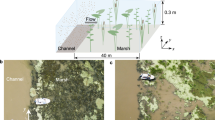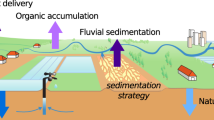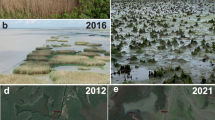Abstract
River deltas support a disproportionate percentage of the world’s population and some are drowning as sea level rises1. Resilient deltas theoretically balance relative sea-level rise with vertical growth from surface sedimentation2,3,4,5,6,7. Vegetation generally enhances inorganic sedimentation and resiliency in some settings, such as tidal saltwater marshes8, but the effect of vegetation on freshwater marshes in river deltas is less clear. Here we use a hydrodynamic numerical model9 to simulate deposition in a river delta with varying vegetation characteristics and water discharge and show that vegetation does not always enhance sedimentation on a freshwater marsh. For a given flood, we find that intermediate vegetation height and density are optimal for enhancing both sand and mud deposition, whereas tall or dense vegetation causes sand to remain in the river channel, reducing marsh sedimentation. A multivariate regression analysis of remote-sensing data from Wax Lake Delta, Louisiana, USA shows that the delta exhibits a hydrodynamic response to vegetation in agreement with model predictions. Because most sediment is delivered to freshwater deltaic marshes by infrequent storm and flood events, we further suggest that the timing of such events relative to seasonal vegetation growth determines the integrated effect of vegetation on delta resiliency.
This is a preview of subscription content, access via your institution
Access options
Subscribe to this journal
Receive 12 print issues and online access
$259.00 per year
only $21.58 per issue
Buy this article
- Purchase on Springer Link
- Instant access to full article PDF
Prices may be subject to local taxes which are calculated during checkout




Similar content being viewed by others
References
Syvitski, J. P. M. et al. Sinking deltas due to human activities. Nature Geosci. 2, 681–686 (2009).
Nittrouer, J. A. et al. Mitigating land loss in coastal Louisiana by controlled diversion of Mississippi River sand. Nature Geosci. 5, 534–537 (2012).
Falcini, F. et al. Linking the historic 2011 Mississippi River flood to coastal wetland sedimentation. Nature Geosci. 5, 803–807 (2012).
Blum, M. D. & Roberts, H. H. Drowning of the Mississippi Delta due to insufficient sediment supply and global sea-level rise. Nature Geosci. 2, 488–491 (2009).
Wilson, C. A. & Allison, M. A. An equilibrium profile model for retreating marsh shorelines in southeast Louisiana. Estuar. Coast. Shelf Sci. 80, 483–494 (2008).
Edmonds, D. A., Hoyal, C. J. D., Sheets, B. A. & Slingerland, R. L. Predicting delta avulsions: Implications for coastal wetland restoration. Geology 37, 759–762 (2009).
Jerolmack, D. J. Conceptual framework for assessing the response of delta channel networks to Holocene sea level rise. Quat. Sci. Rev. 28, 1786–1800 (2009).
Kirwan, M. L. & Megonigal, J. P. Tidal wetland stability in the face of human impacts and sea-level rise. Nature 504, 53–60 (2013).
Lesser, G., Roelvink, J., Van Kester, J. & Stelling, G. Development and validation of a three-dimensional morphological model. Coastal Eng. 51, 883–915 (2004).
Stumpf, R. P. The process of sedimentation on the surface of a salt marsh. Estuar. Coast. Shelf Sci. 17, 495–508 (1983).
Fagherazzi, S. et al. Numerical models of salt marsh evolution: Ecological, geomorphic, and climatic factors. Rev. Geophys. 50, 2011RG000359 (2012).
Rosen, T. & Xu, Y. J. Recent decadal growth of the Atchafalaya River Delta complex: Effects of variable riverine sediment input and vegetation succession. Geomorphology 194, 108–120 (2013).
Morris, J. T., Sundareshwar, P., Nietch, C. T., Kjerfve, B. & Cahoon, D. Responses of coastal wetlands to rising sea level. Ecology 83, 2869–2877 (2002).
Baumann, R. H., Day, J. W. & Miller, C. A. Mississippi deltaic wetland survival: Sedimentation versus coastal submergence. Science 224, 1093–1095 (1984).
Johnson, W., Sasser, C. & Gosselink, J. Succession of vegetation in an evolving river delta, Atchafalaya Bay, Louisiana. J. Ecol. 73, 973–986 (1985).
Edmonds, D. A. Restoration sedimentology. Nature Geosci. 5, 758–759 (2012).
Baptist, M. Modelling Floodplain Biogeomorphology PhD thesis, Delft Univ. Technology (2005)
Nepf, H. M. Hydrodynamics of vegetated channels. J. Hydraul. Res. 50, 262–279 (2012).
Crosato, A. & Saleh, M. S. Numerical study on the effects of floodplain vegetation on river planform style. Earth Surf. Process. Landf. 36, 711–720 (2011).
Arboleda, A. M., Crosato, A. & Middelkoop, H. Reconstructing the early 19th-century Waal River by means of a 2D physics-based numerical model. Hydrol. Process. 24, 3661–3675 (2010).
Baptist, M. et al. On inducing equations for vegetation resistance. J. Hydraul. Res. 45, 435–450 (2007).
Mudd, S. M., D’Alpaos, A. & Morris, J. T. How does vegetation affect sedimentation on tidal marshes? Investigating particle capture and hydrodynamic controls on biologically mediated sedimentation. J. Geophys. Res. 115, F03029 (2010).
Twilley, R. R. & Rivera-Monroy, V. Sediment and nutrient tradeoffs in restoring Mississippi River delta: Restoration vs eutrophication. J. Contemp. Wat. Res. Educ. 141, 39–44 (2009).
Bennett, S. J., Pirim, T. & Barkdoll, B. D. Using simulated emergent vegetation to alter stream flow direction within a straight experimental channel. Geomorphology 44, 115–126 (2002).
Temmerman, S. et al. Vegetation causes channel erosion in a tidal landscape. Geology 35, 631–634 (2007).
Partheniades, E. Erosion and deposition of cohesive soils. J. Hydraul. Div. ASCE 91, 105–139 (1965).
Nittrouer, J. A. & Viparelli, E. Sand as a stable and sustainable resource for nourishing the Mississippi River delta. Nature Geosci. 7, 350–354 (2014).
Kim, W., Mohrig, D., Twilley, R., Paola, C. & Parker, G. Is it feasible to build new land in the Mississippi River Delta? Eos Trans. AGU 90, 373–374 (2009).
Shaw, J. B., Wolinsky, M. A., Paola, C. & Voller, V. R. An image-based method for shoreline mapping on complex coasts. Geophys. Res. Lett. 35, L12405 (2008).
Acknowledgements
This work was financially supported by an NSF Frontiers in Earth Systems Dynamics grant (EAR-1135427), NSF grant OCE-1329542, and funds from the Alfred P. Sloan Foundation. We would like to thank S. Fagherazzi for insightful conversations about vegetation and sedimentation.
Author information
Authors and Affiliations
Contributions
All authors contributed equally in this research.
Corresponding authors
Ethics declarations
Competing interests
The authors declare no competing financial interests.
Supplementary information
Supplementary Information
Supplementary Information (PDF 1943 kb)
Rights and permissions
About this article
Cite this article
Nardin, W., Edmonds, D. Optimum vegetation height and density for inorganic sedimentation in deltaic marshes. Nature Geosci 7, 722–726 (2014). https://doi.org/10.1038/ngeo2233
Received:
Accepted:
Published:
Issue Date:
DOI: https://doi.org/10.1038/ngeo2233
This article is cited by
-
Faunal engineering stimulates landscape-scale accretion in southeastern US salt marshes
Nature Communications (2023)
-
Salt marshes create more extensive channel networks than mangroves
Nature Communications (2022)
-
Competing effects of vegetation density on sedimentation in deltaic marshes
Nature Communications (2022)
-
A Classification Framework to Assess Ecological, Biogeochemical, and Hydrologic Synchrony and Asynchrony
Ecosystems (2022)
-
How Plants Influence Resilience of Salt Marsh and Mangrove Wetlands to Sea-Level Rise
Estuaries and Coasts (2021)



